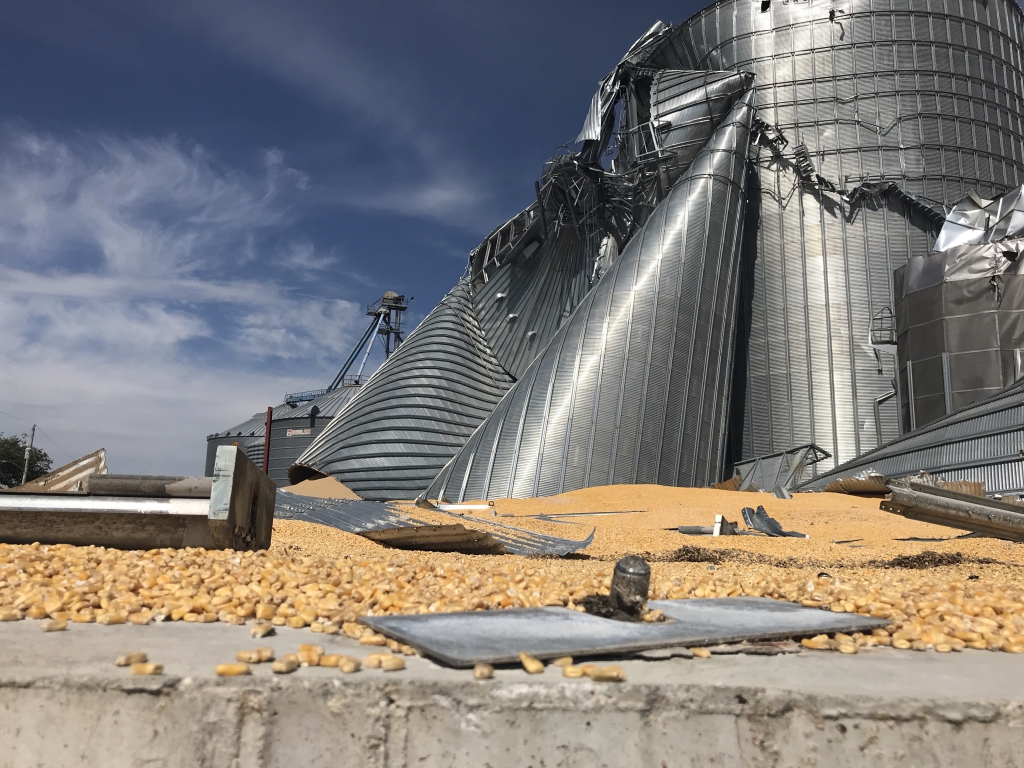civil and environmental engineering
Dan Moser, April 16, 2024
Wittich aims to strengthen grain bins against earthquakes, wind storms
When people think of structural engineering perils, they tend to imagine big-city bridges, skyscrapers and the like, but rural America has key vulnerabilities that could cause major economic upheaval regionally and even nationally.
A University of Nebraska–Lincoln researcher is focusing on a specific piece of structural engineering so ubiquitous across rural America, they are barely noticed — the humble steel grain bin.

Christine Wittich, assistant professor of civil and environmental engineering, has received a five-year, $615,387 Faculty Early Career Development Program award grant from the National Science Foundation to conduct this research.
With her CAREER award, Wittich aims to improve the resilience of rural infrastructure and communities in the face of natural disasters such as wind storms and earthquakes. She’s also integrating an education component to encourage rural students, who are generally less likely to go into engineering as a career, to see opportunities in the field right at home.
The project is an outgrowth of Wittich’s earlier research in the wake of a derecho that hit parts of Iowa in 2020. That storm caused an estimated $11 billion in damage, making it the most damaging thunderstorm event in American history. Much of that damage came to steel grain bins, with some 57 million bushels of stored grain destroyed.
Wittich began her career in California, where earthquake damage to statues was her initial interest. When she came to Nebraska in 2017, she noticed grain bins and center pivot irrigation systems as rural vulnerabilities.
“I was pretty quickly introduced to wind storms … I got interested in rural damage. These structures seemed fairly vulnerable,” and not much research was being done, Wittich said.
There are an estimated 750,000 grain bins across the country; they are designed to hold up to internal pressures, not winds or earthquakes. The failure of a single bin can lead to losses exceeding $250,000, not including the bin itself. To make matters worse, crop insurance policies do not typically cover stored grain.
The bins are a key piece of infrastructure in America’s agricultural economy and the food security of people across the nation and the world, Wittich said. They are susceptible to a range of damage, from even fairly moderate winds or earthquakes, from wall or roof buckling, to complete collapse and destruction.
“There is a critical need to understand the response of these agricultural infrastructure systems under extreme loads and to evaluate the role of these systems within rural community resilience,” she said.
Wittich and her team are working to better understand how steel grain bins hold up under seismic and wind loads through numerical modeling, large-scale experimentation and other steps. That work will include research at the Wall of Wind research facility at Florida International University, where banks of fans can produce up to 150 mph winds. Researchers will build actual bins at the site to see how they hold up.
The team also will experiment with earthquake simulations, using a seismic shake table in the structures lab at the Scott Engineering Center, upon which scaled bins will be constructed and which mimics ground movement during earthquakes.
Ultimately, Wittich’s research could lead to different construction standards for bins.
Beyond that, though, Wittich wants to create outreach opportunities for middle and high school students, with the goal of encouraging more students from rural areas to pursue engineering.
“We’ll introduce them to structural engineering within their communities,” she said. “There’s a noted disparity with students from rural areas pursuing engineering. It’s significantly lower than students from more urban areas.”
A focus on agricultural regions can show students that engineering careers can be built in their home areas, not just urban settings.
“Traditionally in structural engineering classes, you do case studies,” she said. “You look at prominent, high-rise buildings or long-span bridges. That’s great, but that’s not everybody’s community.”
In her classes, Wittich will be incorporating examples from smaller towns, including farming communities.
“Let’s look at how wind will interact with some of these other structures, as well,” she said.
Wittich also wants to promote awareness in rural communities through educational modules and a citizen-science initiative for post-disaster reconnaissance reports. Since researchers can’t scramble to every storm-stricken area, her project will include an app that farmers or other community residents can access to look at past storm damage data and enter new information. This information can help drive further research.
That future research will include other types of agricultural infrastructure and other natural disasters. For example, Wittich said, a recent hurricane devastated poultry housing in Florida.
The National Science Foundation’s CAREER award supports pre-tenure faculty who exemplify the role of teacher-scholars through outstanding research, excellent education and the integration of education and research.





